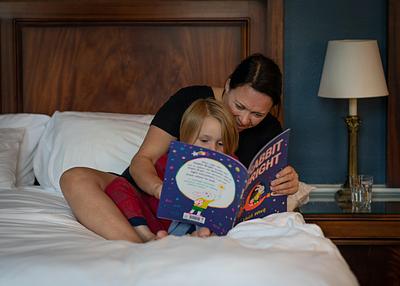In November during Book Week Scotland, every Primary 1 pupils is gifted the Bookbug Primary 1 Family Bag, and every Primary 2 and Primary 3 pupil receive the Read Write Count bags. These bags contain free books to read and enjoy at home.
Here are some tips for sharing picture books, to help you make the most out of the books and the wonderful stories they contain!
Make time to share a story every day
Books are great for any time of day, so make them a part of your everyday routine! You could have a daily trip to space by reading about one of the space missions in The Book of Blast Off in the P3 Read Write Count bag or, if you get the P2 bag, compare the animals or birds you see to those in The Ballad of Cactus Joe when you go out for a walk. Books before bedtime are an excellent way to help your child wind down for sleep. Why not try the Bookbug Primary 1 book My Pet Star to prompt a conversation about winding down for bed?
It doesn't have to be perfect
Reading with young children doesn't have to look like sitting perfectly and reading the book cover-to-cover. You can move around as you read - some children prefer to stand, or walk around, coming closer to look at a specific page. If you're reading Barbara Throws a Wobbler from the Read Write Count P2 bag, you might want to have a go at doing your best impression of each of the moods. If you get Heavy Metal Badger in your P3 bag, you'll find it hard to resist doing your best air guitar! Or if you're reading Holey Moley from the Bookbug Primary 1 Family Bag, you might want to stop and play at being some of the animals, talking about which ones you might see in your local area.
It's also okay or dip in and out of the book, or the story. The Book of Blast Off for example, might be a book that children want to revisit again and again, looking at specific space missions, rather than reading in one sitting. Even with a more traditional story, children might have a favourite page they want to look at again and again, rather than reading the whole book. It's still reading and bonding together, and the experience is more important than "finishing" the book!
Keep books within easy reach
The easier books are to see, the easier they are to read! Try leaving your child's books on the lower shelves of a bookcase or in baskets or plastic tubs on the floor. They can bring you their book when they're ready for a story or choose to explore books on their own. You can also explore different books in different rooms - whether keeping some specific books in their room for bedtime, or keeping some bath-safe books in the bathroom.
Let your child choose
Children will often be more excited and engaged with a story if they have been involved in choosing what to read. Picking out three books and giving them a choice of what they'd like to read (or like to read first) puts them in charge of their own reading, and shows them that their reading preferences are important!
Look at the pictures
Before you start, spend time together looking at the cover, ask your child about what they notice and what they think the story might be about. You can also chat about the pictures on each page and encourage your child to tell the story based on the pictures. Pointing out what you notice in the artwork, and encouraging them to do the same, is a great way to help them uncover more details - and help them see books as something interactive.
Bring the story to life
Why not have a go together at bringing the story to life? Talk to your child about how they think the different characters might speak, and make up sound effects and noises together. You can try changing your tone of voice or your facial expression to suit the emotion of the character in the story. If a character is really happy, then smile and use a happy voice. This helps your child to connect to the different emotions in the story. You could add actions, repeat phrases or even copy what a character is doing. Join in together to bring the story to life! It's okay to feel silly, but don't be embarassed - you're building great memories of playing, being silly and bonding together.
Talk about the story
After you've read the book, ask your child what they thought about it - whether good or bad! Encourage children to tell you why they did or did not like about a book. Talk about what happened in the story, how a character might have been feeling or what they think might happen next. This will help to deepen your child's understanding of the story.
Share your own favourite stories
Your Bookbug Primary 1 Bag and Read Write Count bag might spark memories of what you enjoyed reading as a child, or your favourite picture book. Visit your local library (or scourer your bookshelves or the attic) to see if you can find your favourite picture book. It's really special to share your own favourites picture book with your child. Don't forget to say why you like the story so much, and share your memories of reading it.
Read it again!
Your child may ask for the same book again and again. Each time you share it, they're learning or noticing something new. Reread your Bookbug Primary 1 Bag and Read, Write, Count books as much as you like! Re-reading is a great way to develop vocabulary and understanding of the story, but also an incredibly enjoyable bonding experience.
